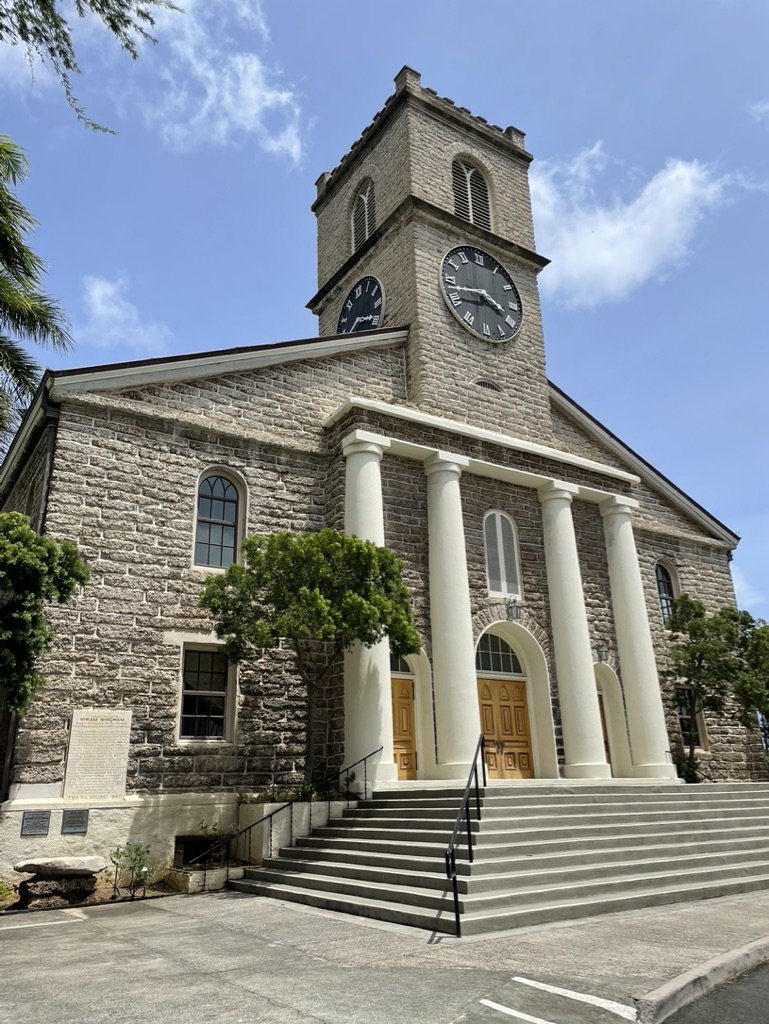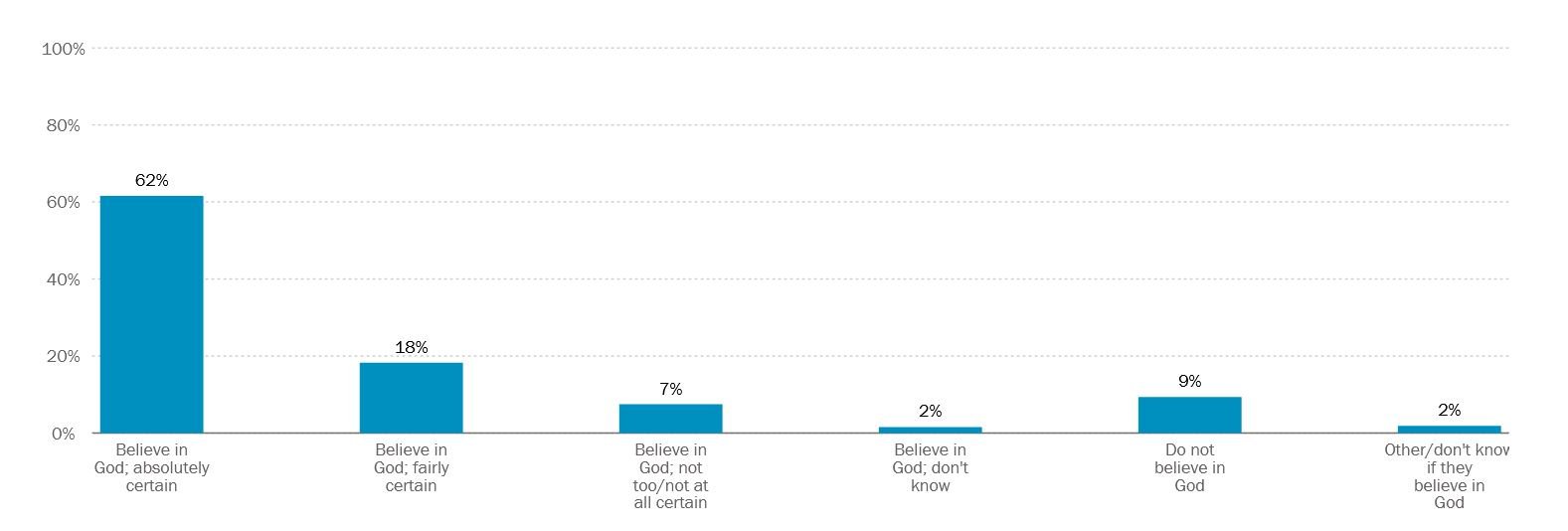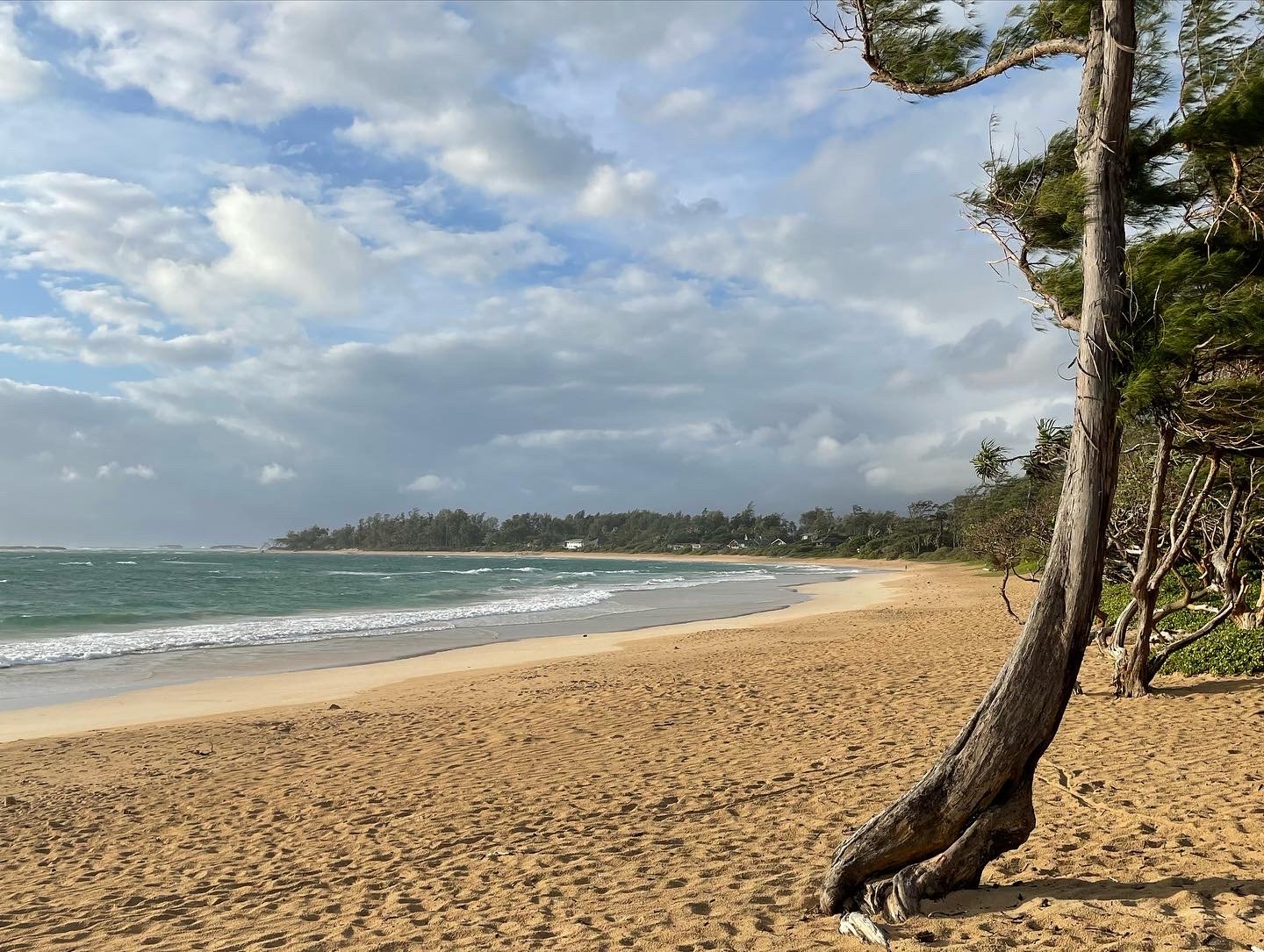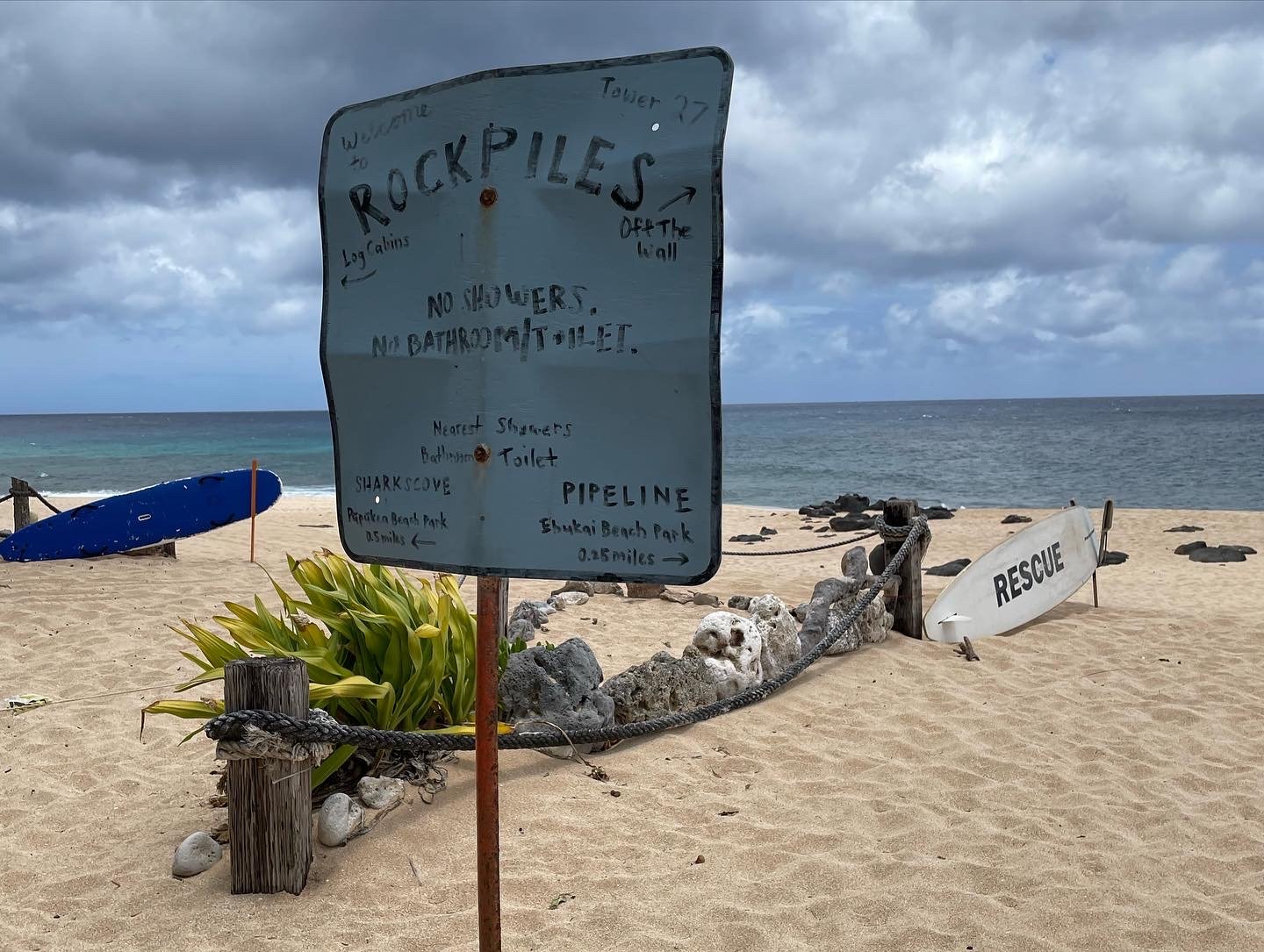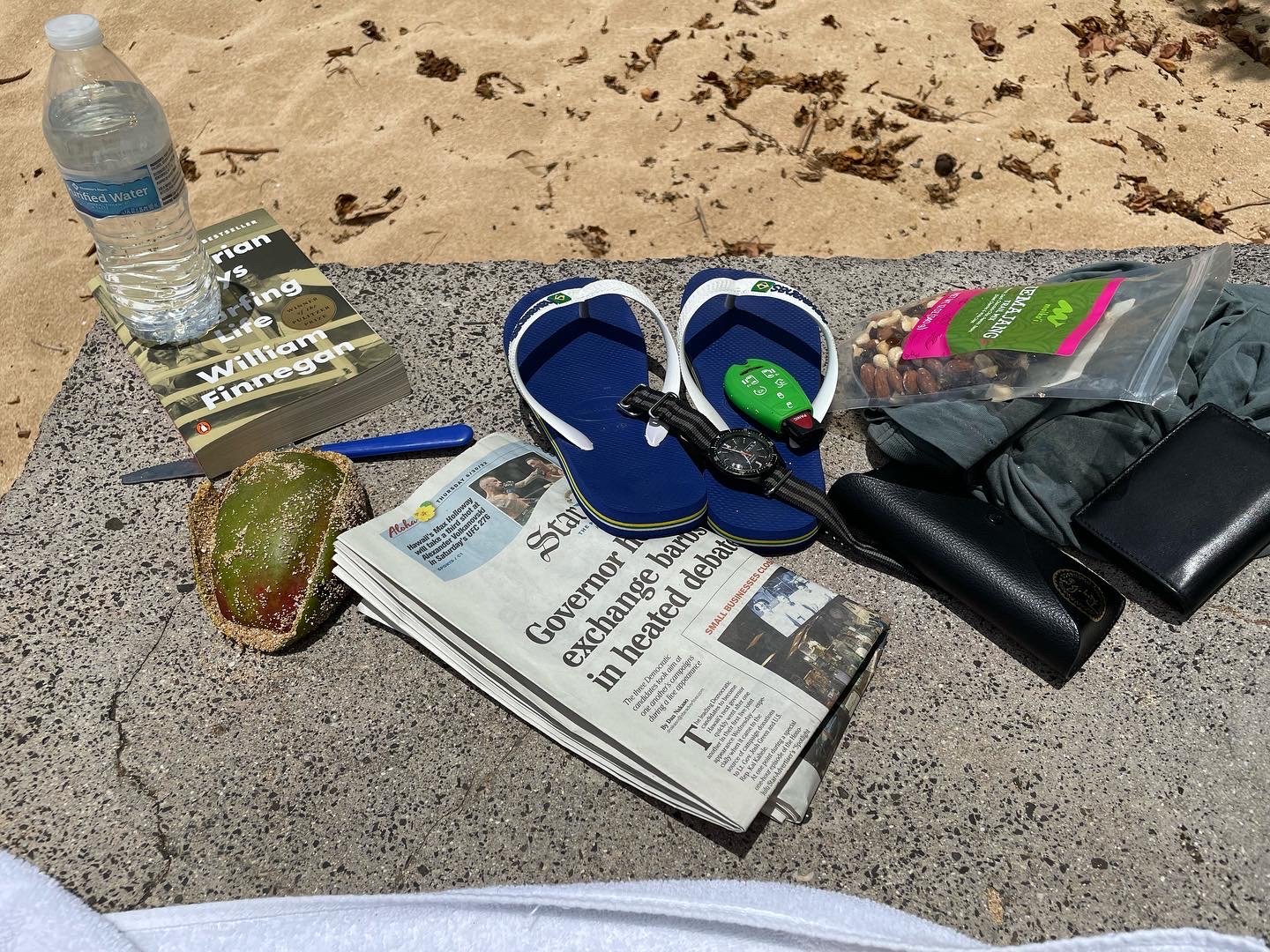Paradise On Wheels: Exploring Religious Oahu From The Mountain To The Sea
Paradise On Wheels
Exploring Religious Oahu From The Mountain To The Sea
KAHUKU, Hawaii — As I drive my rented stealth camper van along the Kamahameha Highway on Oahu’s North Shore, the reality hits me like a 50-foot wave at Waimea Bay: Hawaii is religiously robust.
We’ll come back to my “Hale on Wheels” — “hale” means “home” or “house” in Hawaiian — later in this journey. For now, let’s explore the bountiful and pluralistic religious life one sees throughout the island of Oahu.
Earlier in the day, I join a dozen journalists on a bus tour of the Honolulu area. We’d all spent a few days at the East West Center’s international media conference, listening and discussing themes on “Connecting in a Zero Trust World.”
On a post-conference tour, we hear about the history of native Hawaii, including the spiritualism on the island. We stop at a sacred place — oddly, unmarked and located behind a YMCA day camp set at a Christian church — where Hawaiian natives worshipped their gods and offered sacrifices (yes, including some human ones). The ancient Hawaiians used enlightened concepts for organizing agriculture and land into “ahupua`a,” triangular, pizza-shaped wedge slices of land that extended from the mountain in the middle of the island to the sea, allowing water to flow, irrigating crops and providing spiritual meaning — a belief system about the interconnectedness of elements.
“The ancient ahupua`a, the basic self-sustaining unit, extended elements of Hawaiian spirituality into the natural landscape,” according to HawaiiHistory.org. “Amidst a belief system that emphasized the interrelationship of elements and beings, the ahupua`a contained those interrelationships in the activities of daily and seasonal life.”
Kawaiahao Church. Photo: Paul Glader
We visit one of the first churches in downtown Honolulu — Kawaiahao Church — made from white coral and dedicated in 1842. Nicknamed the “Westminster Abbey of the Pacific,” the church offers services in Hawaiian and English each Sunday. Unfortunately, my trip is Monday to Saturday, which means I can’t visit a service. Everywhere we go downtown and on the outskirts of Honolulu seem populated with houses of worship and infused with spiritual meaning.
Pew Research data shows an amalgam of religious belief among Hawaii’s population of 1.4 million across all its islands, which is 63% Christian — including 25% evangelical Protestant, 20% Catholic, 11% mainline Protestant and 3% Latter-day Saints — 8% Buddhist and a mix of other minority faiths.
Tectonic religious shift in the 1800s
Missionaries arrived in Hawaii in the 1800s, not long after Captain James Cook arrived in the islands in 1778, and observed the unique Polynesian culture that developed over centuries. Hawaiians pioneered the sport of surfing and excelled at arts such as feather work and hula. They also added their own deities, such as Madame Pele, the goddess who some believe created the Hawaiian Islands via volcanoes and fire. The History Channel reports some interesting religious conflict with Captain Cook when he spent time in Kelakekua Bay on the island of Hawaii:
“Kealakekua Bay was considered the sacred harbor of Lono, the fertility god of the Hawaiians, and at the time of Cook’s arrival the locals were engaged in a festival dedicated to Lono. Cook and his compatriots were welcomed as gods and for the next month exploited the Hawaiians’ good will. After one of the crewmen died, exposing the Europeans as mere mortals, relations became strained.”
Captain Cook and his men tried to flee but storms, conflicts and failed negotiations revealed the European visitors were not deities but, rather, mortals. Although natives killed Captain Cook and his men in that skirmish in 1779, other explorers followed.
King Kamehameha consolidated power, taking control of the main islands using Western technology such as cannons and muskets. After he died in 1819, his son, Liholiho, took over and toppled the old Hawaiian religion without offering an alternate belief system. Around that same time, in 1820, a group of 14 American protestant missionaries — seven couples who were Presbyterians, Congregationalists and Dutch Reformists — started arriving from New England with four Hawaiian boys. The American Board of Commissioners for Foreign Missions sent and funded the group.
The Rev. Hiram Bingham built a mission headquarters in Honolulu on land assigned to the group by King Liholiho, who himself was based on the island of Hawaii. The missionaries quickly started codifying the written form of the Hawaiian language, the first group to create such a consistent form of the oral language. They set up the first island printing press in Honolulu. Bingham opened “singing schools,” where Native Hawaiians learned Protestant hymns in the Hawaiian language. More missionaries continued arriving and contributing to education, government and business development.
The global surf community loves recalling the story of Christian missionaries being upset that natives in Hawaii surfed naked on wooden boards. It’s unclear if public health concerns, such as worries of slivers in sensitive body regions, were another concern of the missionaries. Either way, surfing continued and eventually spread to California and all over the world. While some critics accuse the missionaries of exercising cultural and religious imperialism, others such as the writer of an Associated Press article accuses the global surf community of cultural appropriation. Meanwhile, houses of worship became more and more part of the culture on the Hawaiian islands.
As our group rides around downtown Honolulu, I see Anglican churches, Lutheran churches, Pentecostal churches, a Buddhist center, a Jewish synagogue and other houses of worship. Lots of “Jesus Saves”-type signs and bumper stickers appear on cars and yard signs around Honolulu and other smaller villages of Oahu.
Arriving in the land of Latter-day Saints
After the bus tour, I take an Uber one hour away to Laie to pick up my fully customized Dodge Caravan stealth camper van, called “Hale on Wheels.” I rented this van on Airbnb after searching for a hotel on the North Shore and finding few-to-no good options. “Your adventure begins in a hand-crafted and reliable vehicle with thoughtful touches for a comfortable stay,” the listing said.
It turns out you can’t just sleep in your van anywhere in Hawaii. In fact, it’s technically illegal to sleep in your car in this state. I thought about canceling my van adventure, wondering whether it was refundable.
Yet, there was a workaround. You can book a van camping spot at two beach campgrounds for an extra fee. I booked Thursday night at Malaekahana Beach Campground. It had no availability for Friday night. So, I tried to book a night at Camp Mokuleia, an Episcopal Church-owned beach camp. I thought, “How cool! The church owns a beautiful stretch of beach and makes it available to camp.” I wanted to do a podcast interview or story on that. But, alas, Camp Mokuleia was booked full. No room. No podcast.
It turns out the Episcopalians are not the only ones with a foothold on the North Shore beaches. The Church of Jesus Christ of Latter-day Saints, historically known as Mormons, have a serious presence on the North Shore in the town of Laie, where I picked up my Hale on Wheels.
The Hale. Photo Paul Glader
As I am in the checkout line of the Foodland grocery store, I hear an ebullient woman in line behind me chatting perkily with a couple with four children.
“Where are you from, and how long are you here for?” the woman asks with a sing-songy tone.
“We are native Hawaiian, but we live in Utah,” the man says, noting they returned for a family event.
“Oh! Nice!” the woman says, explaining she had been to Utah for training, dropping references to mission work, Provo and other Latter-day Saints-affinity signaling.
After loading my simple groceries into the refrigerator (a cooler) in the kitchen of my van (a 2-foot by 3-foot built-out kitchen in the trunk), I decide to go to Seven Brothers Burgers in the same shopping mall. The place has a surfer vibe with concrete floors and simple wood tables. The young blonde woman at the register possesses a similar cheery attitude as the 40-something woman in Foodland but with more beach style.
As I charge my phone and eat the delicious Teri-Samoa burger and homemade “fries” (highly recommend, as they slice and fry potatoes on site), I notice a picture of the seven brothers on the wall, along with their business manifesto scrawled onto a board in surf-style font. The brothers cite their family values and love of surfing, parents and food as motivation to open the restaurant.
“As you can imagine, our house was a revolving door of chaos, with lots of laughter, no privacy, friends funneling in at all hours, long talks about life, and constant rough housing. Our parents taught us to love God, love others, and love surfing,” their website explains. “We were humbled very quick, but in time we found success with lines out the door and sometimes around the corner. Like dad always used to say, ‘I think God is reaching down touching each burger with his finger.’”
I don’t know if God touched my burger with his finger, but it is tasty. Meanwhile, I wonder if the seven brothers and their expanding families of nearly 40 people, too, are Latter-day Saints.
“I saw you at Temple today,” the young woman at the register says to an older couple who stopped in for a burger. Indeed, this seems to be another LDS-oriented establishment.
Driving to my beach campground, I see signs for a Temple Beach Park and the local Latter-day Saints temple rising majestically down a road from the ocean. I also realize I had driven by the Polynesian Cultural Center a few miles earlier and that it is affiliated with the Brigham Young University campus in Oahu.
Earlier in the week, some journalists in Honolulu told me the Mormon church created the Polynesian Cultural Center so that they could evangelize native Hawaiians. I checked out the website and saw that, indeed, the center is operated by Latter-day Saints and offers people a tour of the BYU campus. Later, a friend who is a former Mormon explained more details of the theological and cultural underpinnings of the Latter-day Saints’ expansion in Hawaii.
He explained that the Latter-day Saints showed deep interest in the Polynesian people from the time the church organized in 1830. Just a short time later, in 1843, the Prophet Joseph Smith sent missionaries to islands in the Pacific. An essay on a BYU website notes that the Book of Mormon mentions Hagoth, a Nephite shipbuilder who left the Americas and sailed away and was “never heard of more.” Mormon theologians and historians think Hagoth sailed to the Asia Pacific, perhaps Hawaii. That theory then means some Latter-day Saints think Hawaiians have the blood of Nephi in their veins and that God must awaken them to their identity as Mormons.
“The Church believes that the Polynesians are direct blood relatives of Lehi’s colony and that Hagoth’s lost ships provide at least one connection between the Americas and Polynesia,” writes Robert E. Parsons in an article on the BYU website. “The brief account of Hagoth recorded in the book of Alma is important to an understanding of the blessings given to the descendants of Joseph, as the inhabitants of the isles of the sea.”
With this mythology, the church perhaps aims to perform historical ju-jitsu on the Moana-type stories about the origins of the Pacific Islands, especially the Hawaiian Islands.
“It’s the most blatant form of cultural appropriation ever,” my former Mormon friend said.
Belief in God among adults in Hawaii. Chart via Pew Research Center.
Not so one with nature
I get to the Malaekahana Beach Campground and realize it’s closed for the night. They left me a parking pass, but I have no chance to get to my campsite because a locked gate blocks the road. So, I set up the Hale on Wheels in front of the main office.
It tales me a while to figure out where to put my suitcase, how to charge my phones, how to get the fridge cooler working, how to set up the bed, how to close the curtains. The van is also warm, super warm. I experiment with various windows open to get a cross breeze flowing through the van, but I wake up sweating several times.
The next morning, I wake early to the sounds of roosters, ocean wind and cars passing on the highway. I step out and see chickens, cows and wind turbines across the road. I text my wife, who is back in New Jersey and slightly amused and nervous about my camping adventure.
Me: Yeah. Am having a funny time with this camper van. Glad to try this once — but probably never again. Haha. 😂
Wife: It literally looked like a vehicle with a mattress. They really stretch the definition.
Me: Yeah. They kitted it out quite a bit. They have a separate battery that powers outlets inside as well as a refrigerated cooler. They have a propane stove that pulls out, a little faucet etc. curtains all around for you to sleep easily. It’s clever and cute but a bit chintzy too — everything is a hassle. I kind of miss just having a bathroom to pee in during the middle of the night instead of a sliding van door and walking into the woods in the dark. :) It also gets hot in the van at night. So, I cracked open four windows to create a cross breeze in this Hale on Wheels.
Wife: It sounds like a Barbie toy that seems cute but not so functional. And yes, I was totally thinking about cooling.
Me: Yes. It’s functional in a way for influencer people who want to wow their friends with photos of a surf trip that looks magical. The back door of the minivan reveals a cutesy kitchen. But they aren’t showing the pain in the butt elements of #vanlife.
Wife: The sweating, the glory of urinating in nature. Torching your eyebrows on the propane stove.
Me: This thing has a roof rack that contains a table and chairs and a “shower.” But they admit in the video tutorial that the shower is more just a little tank that allows you to “spray yourself” a little bit. You should really use campground cold outdoor showers they say.
Again, very cutesy. But…?
Wife: Sounds cute as in like bull----.
Me: They do provide towels. Tons of nice bedding. And a surprising array of cooking gear. #VanLife is overrated in my humble opinion. Then again, maybe a more spacious van feels more luxurious.
Wife: I just don’t understand wanting to live like you’re homeless… For people who are long term Van folk
Me: That seems to be just a trendy twist in the old RV phenomenon. A more affordable way to see the country and be nomadic in America.
Wife: No thanks…
Day-tripping around the North Shore
My free day on the North Shore is a dream, revealing why people call Hawaii a paradise. I swim in the ocean, jog on the beach and read the Pulitzer Prize-winning surfing memoir “Barbarian Days” by New Yorker reporter William Finnegan, some of which is set on Oahu.
At one point in the book, Finnegan describes a lineup for waves in Oahu amid a crowd of other surfers. “The whole scene had the feeling of a religious shrine overrun by passionate pilgrims,” he writes. “I half expected people to start speaking in tongues, to flail and foam at the mouth, or monastery monkeys to bomb us with guavas.”
Though I am a beginner surfer who has surfed waves from the Americas to Spain to Morocco and long dreamed of surfing in Hawaii, I am hindered this trip from surfing because of a knee surgery. The last thing a knee in rehab needs is violent, twisting motions on unpredictable ocean waves.
I visit the campground office. Thankfully, I am able to book a second night at the campground. As I charge my phone outside the office, I meet a young German couple on their way to the Polynesian Cultural Center. We speak some German and talk about their visit to Oahu. I mention the Latter-day Saints connections to the cultural center, and they ask several questions, intrigued with the new information.
Eventually, I set off on a road trip around the North Shore. I stop for lunch and a dip at Banzai Beach near the famous Pipeline wave. A native lifeguard and I chat about life, surfing and beaches. He tells me he travels to New Jersey to help with a surfing program for autistic kids. “God bless,” he says as I trudge off in the sand to read by the ocean.
As I drive further west on the North Shore, I cruise by the famous surf beach Waimea Bay and stop for a poke bowl (10,000 times better than poke bowls in New York City) and some shopping in the small town of Haleiwa. I see a church — Liliuokalani Protestant Church — that dates back to 1832 in the tourist town near Waimea Bay. At one point, worshippers blew notes on a large conch shell to signal church was starting. Today, the church’s motto is “e onipa’a mau i ka hana o Ke Akua,” which means “remain steadfast in the work of the Lord.”
On my drive back to the campsite, I see a family parked by the side of the busy two-lane road and I wonder if they are in trouble. The mom is bent over, dusting sand off a child before cramming her children in the car. Wondering if the family had a flat tire or something, I slow down and look closer, noticing something unusual about the woman’s ample fanny greeting the traffic whizzing past. I divert my eyes back to the road, puzzled by the flesh-toned pantaloons stretched long past her beach shorts. Later, I realize the unusual leggings were LDS-sanctioned holy underwear.
A Marian Catholic shrine in the woods
Nervous about being locked out of the Malaekahana Beach Campground and sleeping in the parking lot again, I arrive early enough to cruise several circles and find my way to a God-forsaken camping site that is 100% dirt and under tree cover. I see feral chickens and chicks scampering about the place. I decide to park the stealth camper van in a grassy area next to the campsite.
Catholic shrine in Malaekahana Beach Campground. Photo: Paul Glader
For a few hours, I go through the rituals of setting up the camper before I head to the beach for a walk and reading session. As I walk the campground, I come across a lovely makeshift shrine to Mother Mary in the woods. It was clearly set up by some deeply Catholic campers. It was beautiful in its natural environment, right in front of a tree.
Hawaiian families and church youth groups seem to camp in many of the sites at this beach campground. I realize that camping is one way to see some of the “real” Hawaii. As the Fourth of July weekend is coming up, I also see Hawaiian family groups with American flags and barbecues, celebrating their unique status as Americans on an island in the Pacific Ocean.
The next morning, I wake up for several swims in the ocean and readings before I drove east toward Laie to grab a bite to eat and to return the Hale on Wheels.
Worried that a cough and itchy sore threat mean I have COVID-19, I mask up all day and try to find a pharmacy where I can buy a COVID test. On the other hand, I can still taste the delicious papaya and mango. So my symptoms were mixed. Unfortunately, the pharmacy at the grocery store in Laie didn’t carry COVID tests.
For a few hours, I wonder if I test positive for COVID how I will quarantine. It seems a hotel stay on Waikiki Beach for a week will be in order, no? I called home, though, and my wife is not on board with this idea. “Get on the plane!” she instructs, whether I get a COVID test or not. She has a graduate degree in public health. So, I obey.
The Latter-day Saints temple in Laie, Oahu. Photo by Paul Glader
I drive by a Jehovah’s Witness church. I see a Seventh-day Adventist church on the map. I also see the massive Laie Latter-day Saints temple and decide to pull in to take a couple pictures. I walk the entrance and hear hymn music playing from speakers. I don’t step into the visitor’s center in case I have COVID.
Shortly after, I come across BYU Hawaii’s Oahu campus. I’d met many journalism students from this school at college journalism conferences over the years. I drive a circular cruise around the main campus, taking in the architecture. I figure if I were Mormon — a zero chance, as I love caffeine too much as well as my own religious faith — I would probably want my kids to go to a school like this in Hawaii for its proximity to the beach.
Driving on, I stop in at the Polynesian Cultural Center for a lunch of crepes with Hawaiian pulled pork. The place seems clean and upbeat but too phony and preppy for my taste.
I return the Hale on Wheels to its rental parking spot and hail an Uber to take me to the Pearl Harbor memorial site. My driver, Le, shows up in a minivan. He was from Vietnam originally. He wears Buddhist beads on his wrist. A plastic Buddha bobblehead figurine rides with us, affixed to the dashboard. We zoom past more churches: Catholic, Lutheran, Presbyterian, Episcopal, Pentecostal.
On our drive, I see a sandwich sign for Anchor Church and its four weekly worship services at the foot of a massive mountain near Kane O’he. At Pearl Harbor, I walk through the solemn exhibits, sit through the films and pay my respects to our soldiers who died that fateful day.
Hailing a final Uber, I arrive at the airport and fly home. Typing this on the plane while listening to soothing Hawaiian music, I further realize my first journey into a paradise on earth has shown me a surprising bounty of religious depth and diversity. Back in New Jersey, I take a COVID test. It turns out I didn’t have COVID. Thanks, er, Maholo, be to God.
Paul Glader is executive editor of ReligionUnplugged.com and a professor of journalism at The King’s College NYC. He has reported from dozens of countries for outlets ranging from The Wall Street Journal, The Washington Post, Der Spiegel Online and others. He’s on Twitter @PaulGlader.


